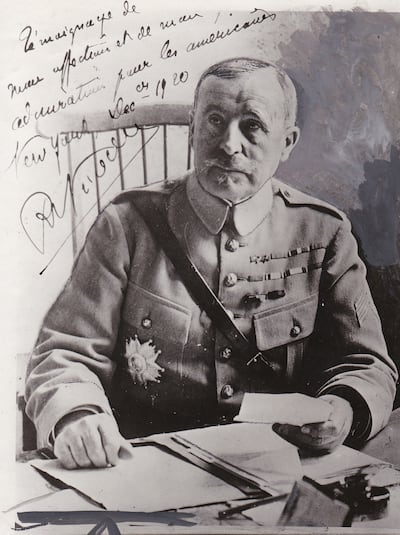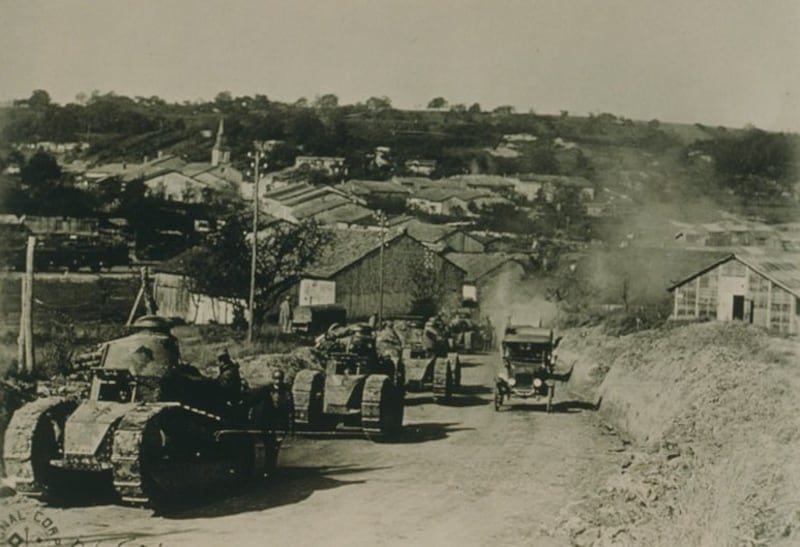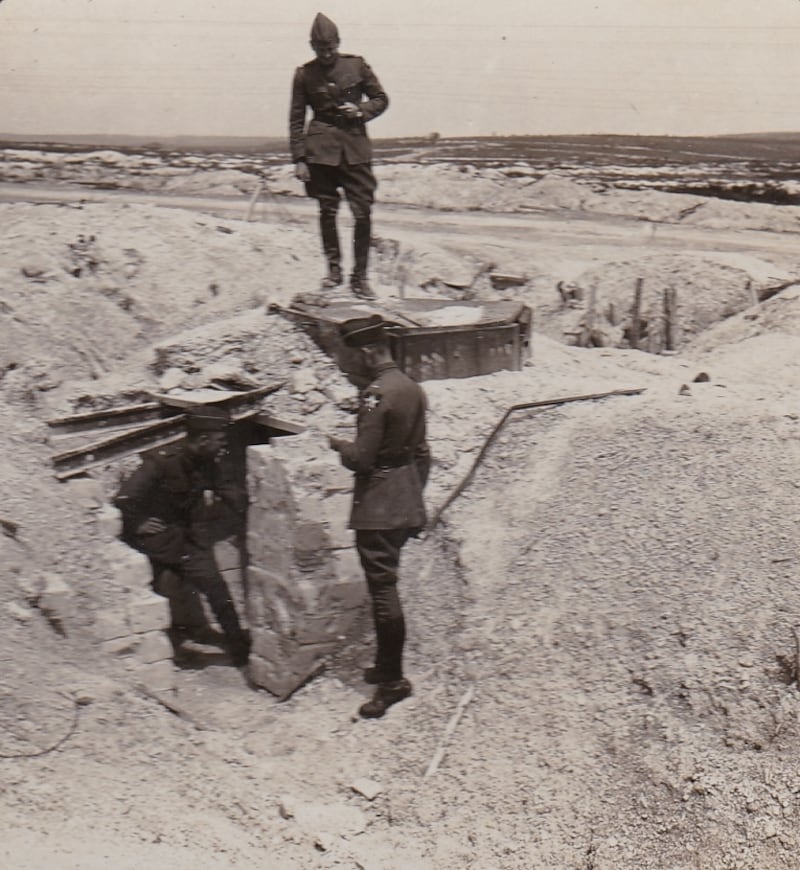Having suffered enormous casualties during the defence of Verdun and in the big offensives on the Somme, the political leaders and commanders of the Allied nations met in Paris on November 15th and 16th, 1916, to plan a new phase of offensive operations.
The strategy for 1917 was shaped by decisions made at this conference; it was hoped that concerted action would bring victory by the summer of that year.
In essence the grand plan remained largely unchanged from that of the previous year: there would be a major offensive on the Western Front in the spring of 1917, with a series of lesser offensives in support. The Italians would mount yet another attack on the Isonzo front while the Russians promised further major offensive action in the east. In light of high German and Austro-Hungarian casualties in 1916, the Allied leaders felt confident that the enemy armies were close to collapse.
Further conferences followed in Rome, Calais and London, and by early 1917 plans were set. Rather than bring victory, however, 1917 would bring the Allies close to collapse.
Alongside the difficulties of co-ordinating these large and dispersed operations, serious personality issues emerged within the Allied leadership. In December 1916 the French commander, Gen Joseph Joffre, was finally replaced. The French premier, Aristide Briand and his Union Sacrée government had long been alarmed by Joffre's cavalier attitude to French casualty figures.

His successor was Gen Robert Nivelle, a charismatic and enthusiastic officer who had risen to public prominence during the later phases of the Verdun battle in 1916. He now promised that his plans for a big offensive in the spring would bring total victory within 48 hours.
A charming but devious man, Nivelle became embroiled in a plot with the British prime minister, David Lloyd George, to have the British Expeditionary Force put under French command. For Lloyd George this was in an effort to reduce the power of the British commander, Field Marshal Sir Douglas Haig, whom he saw as responsible for the failures and high casualties of 1916.
Although this plan came to nought, it poisoned the relationship between Nivelle and Haig and further played into the concerns of both British and French politicians, prompting them to increase their efforts to obtain more control over the conduct of the war.
While the Allied leaders and commanders were wrangling among themselves the German army took the initiative. As part of their new doctrine of “defence in depth”, in February 1917 the Germans began withdrawing into new prepared positions that we know today as the Hindenburg Line. In some places these new defences were several kilometres deep and incorporated multiple lines of trenches, concrete blockhouses, large wire entanglements and booby traps.
The German planners also factored in defensive-fire plans and the intelligent use of counterattack units. This should have given Nivelle pause, but he ploughed ahead with his plans despite growing opposition from his army commanders and from French politicians. In March the Briand government fell, but the opportunity to replace Nivelle passed, and the plan went ahead under the new government of Alexandre Ribot.
On April 9th, 1917, offensive operations opened with a diversionary British attack at Arras and Vimy. Canadian forces had a remarkable success in taking the key terrain of Vimy Ridge; British forces struggled elsewhere but kept on the offensive because of developing French difficulties.

For his own offensive Nivelle has assembled more than a million men and 5,300 artillery pieces, with a stockpile of more than 11 million artillery rounds. Nivelle would also use more than 100 tanks in the first-ever massed tank attack.
Operational security was poor, however, and the Germans had a good picture of French intentions by the time the offensive opened on April 16th, in driving rain and sleet. The main effort went in on the Chemin des Dames, poorly chosen ground for a major action. Having struggled across a canal and a river, French troops fought into the high ground of the Chemin des Dames before encountering the main German defences. The attack faltered and stalled, resulting in more than 30,000 deaths and 100,000 casualties.
Rather than call off the attack as he had promised, Nivelle persisted until his removal, in May. The failure plunged France into despair. While the attack was ongoing there were outbreaks of "collective disobedience" within the French army. By June it was in the grip of series of mutinies that eventually affected 54 divisions of the French army.
The new French commander, Gen Philippe Pétain, set about restoring order using both coercive and conciliatory measures. Following courts martial and executions, order was restored and the leave and service conditions of the French soldier improved. Nevertheless, the French army was badly shaken and would remain unfit for major operations for some time.
For the rest of 1917 the burden of operations fell to the British Expeditionary Force, and this would affect how later offensives unfolded. Haig was aware that the French had problems, but Pétain did not tell him of their full extent. This concern factored into Haig's own plans for a series of offensives in Flanders during the remainder of the year. These, Haig believed, would clear the Germans from the English Channel ports before leading to breakthrough and the destruction of the German army.
The initial "shaping operation" opened on June 7th at Messines. After meticulous planning Gen Sir Hubert Plumer launched a huge attack aimed at pushing the Germans out of their dominant positions along the Messines ridge line. The offensive was preceded by the detonation of a series of underground mines collectively containing more than 600 tons of explosives. Their detonation created one of the largest ever non-nuclear explosions. It was later reported that the detonation sent a shock wave as far as Dublin.
From an Irish perspective the Battle of Messines saw the involvement of both the 16th Irish Division and the 36th Ulster Division, operating side by side in their successful advance. By first World War standards, casualties were comparatively light, at about 17,000, in exchange for what was seen as a major advance. Optimistically, it was thought that this was a prelude to greater success and that German resistance was crumbling.
The Messines operation was followed by the Third Battle of Ypres, or the Battle of Passchendaele as it came to be known. It has become a byword for military failure, characterised by high casualties and sheer misery. The offensive opened on July 31st without a fraction of the preparation of the Messines operation. Attacks were poorly supported and co-ordinated, and casualty figures mounted for little gain.
The main burden of the offensive fell to the Fifth Army under Gen Sir Hubert Gough, with support from Second Army under Gen Plumer. Sadly, these formations included the 16th Irish and 36th Ulster Divisions and other Irish units. In later operations the troops struggled to fight and advance through the clinging mud of Flanders and were decimated in repeated, and mostly futile, attacks along the Menin Road and on positions at Langemarck, Polygon Wood, Poelcappe and Passchendaele village. Haig persisted in the offensive until November 6th, when Passchendaele village fell to Canadian and British infantry following a bitter fight. Total British casualties numbered more than 310,000, for no strategic gain.
Lowest points
It marked one of the lowest points for the Allies during the first World War. Alongside British and French difficulties on the Western Front, Russia experienced revolution in February 1917 followed by decisive defeats in Galicia (July) and Riga (September). Following the Bolshevik October Revolution, Russia was effectively out of the war, signing a separate peace with the Germans at Brest-Litovsk in March 1918. Italy had also come close to collapse after the spectacular Austro-German Caporetto Offensive, in October. At sea the activities of German U-boats were also putting the Allies under pressure.

There were some positives. On April 6th, 1917, the United States came into the war on the Allied side. Although the Americans had a relatively small army it underwent a huge expansion, and by 1918 more than two million US troops were in Europe. They would significantly boost manpower for the final offensives of the war – but not without cost.
Also, in the Middle East, there were Allied successes as British, French and Arab forces gradually pushed back the Ottoman army. In March 1917 troops from the Indian army captured Baghdad, a prize that had eluded the Allies since 1914. A few months later, in July, TE Lawrence ("of Arabia"), then an obscure junior officer, took the strategically important port of Aqaba. In December forces under Lord Allenby captured Jerusalem, following the breaching of the Beersheba-Gaza line and subsequent advances. Considering the difficulties on the Western Front, it is little wonder that so much was made of such successes in Allied propaganda.
Nineteen-seventeen was also a significant year in Ireland. The escalation of the U-boat war saw multiple sinkings in Irish waters. Also, the repeated attacks on the Western Front had resulted in the deaths of thousands of soldiers from all over Ireland.
The year also saw significant political developments. In a series of byelections the Irish Parliamentary Party lost a series of byelections beginning with North Roscommon.. Alarmed by this development, David Lloyd George called for immediate home rule for the southern 26 counties.
In July Éamon de Valera won the East Clare byelection, which had been caused by the death in action of the sitting MP, Willie Redmond, at the Battle of Messines. This was followed by a Sinn Féin byelection success for WT Cosgrove, in Kilkenny in August. The Irish Convention, which first met on July 25th at Trinity College Dublin, and would run in phases until March 1918, was an attempt to refocus the debate on home rule. But Irish politics was changing along more radical lines, witnessed by increased support for Sinn Féin and with Irish independence becoming the avowed goal.
Final offensive
In the military sphere the year ended with one final offensive on the Western Front. On November 20th the British launched a surprise offensive at Cambrai, using more than 470 tanks in the largest tank attack yet seen.
Initial success encouraged Haig to continue the attack, and good progress was made until November 30th, when the Germans launched a huge counterattack, using 20 divisions. By the time the battle petered out, on December 7th, the Germans had regained almost all of their lost territory. Although the offensive suggested the future potential of the tank if used properly, Cambrai was a strategic nonresult for the British, in the course of which they suffered more than 45,000 casualties.
Having begun the year in a spirit of optimism, with a seemingly inspirational leader in Gen Nivelle, 1917 became a year of failed offensives. Even the successes at Messines and Cambrai were overshadowed by later failure. The year ended with all the surviving Allied nations grimly hanging on with increased political and social agitation on their home fronts.
It was perhaps the most dangerous year for the Allied cause, with Russia out of the war, while both France and Italy also came close to collapse. For Haig and Pétain and their subordinate generals, it was hoped that the American Expeditionary Forces
under Gen John Pershing would make victory possible in 1918. It was also hoped that the combined use of tanks, air power, improved artillery and new tactics could bring success. Despite their difficulties there was no unified command, and an overall Allied commander would not be appointed until 1918.
In a strategic sense there seemed to be little option but to continue operations on the Western Front, in the hope of knocking Germany out of the war. Yet, not for the first time, it was the Germans who seized the military initiative. In their spring offensives of 1918, collectively known as the Kaiserschlacht, they would make a final effort to end the war on their terms, seriously challenging the Allied commanders and their weary troops.
Dr David Murphy teaches military history and strategic studies at Maynooth University







